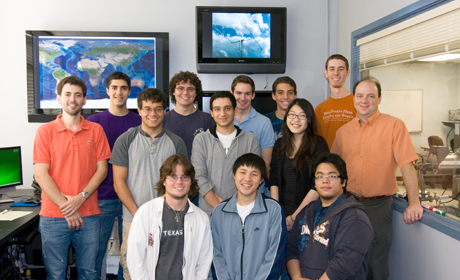 The FASTRAC satellites built by students over seven years were launched from the Kodiak Launch Complex in Alaska Nov. 19. Photo by Steven Young/Spaceflight Now.
The FASTRAC satellites built by students over seven years were launched from the Kodiak Launch Complex in Alaska Nov. 19. Photo by Steven Young/Spaceflight Now.Shortly after midnight on Nov. 20, Professor Glenn Lightsey let out a "whoop" of excitement in front of his computer screen.
Seven years of work by more than 150 students on a shoestring budget had culminated three hours earlier in the launch of a satellite package from the Kodiak Launch Complex in Alaska. Now, the satellites were beaconing from space.
"It was almost surreal because we had been waiting for a long time to see our satellite launch, and when it actually happens, you're not even sure how to respond," said Lightsey, the students’ faculty advisor on the project, known as FASTRAC. "It was kind of emotional because it was something we had invested so much of ourselves in."
Entirely run by graduate and undergraduate students, the FASTRAC project is the first student-developed mission in which satellites will orbit and communicate with each other in real-time.
The project is sponsored by the U.S. Air Force and began in 2003 with the goal of developing space technology that's more affordable and therefore more accessible while training and educating future engineers. Students used a hardware budget of only $250,000, a drop in the bucket compared to the millions typically spent on spacecraft missions, to build the tire-sized satellites. Named Emma and Sara Lily, the 60-plus pound satellites have the ability to separate from one another and to communicate with each other on their location and attitude determination data from their on-board GPS systems.
If successful, they could redraw the boundaries of what is possible in space technology and open the door for more complex satellite missions that require real-time coordination between small satellites.
“This is very progressive, forward-looking technology that the Air Force and NASA are very interested in because you can have smaller satellites that are more effective as a group than a single more expensive satellite," Lightsey said.
The application possibilities for the satellites are also endless — from changing the way routine maintenance is done to improving safety to help prevent tragedies like the Columbia space shuttle disaster in 2003. The Columbia crew was unaware of a hole in the left wing that caused the shuttle to disintegrate upon reentry into the Earth’s atmosphere.
“If they would have had the technology that could go outside the shuttle and inspect it, then the hole could have been discovered,” Lightsey said.
In fact, a small satellite may even be able to repair the hole. They could also be used to refuel other satellites, or a large group of satellites could take multiple, coordinated pictures of the Earth in a way that’s never been done before, Lightsey said.
Since the November launch, the student team is about halfway through the second phase of the project, a month-long initial check-out period. Next, the team will move to phase three – the highlight of the mission – to see if they can command the satellites to separate and successfully communicate.
Sebastian Muñoz, a graduate student and FASTRAC project manager, said this phase will demonstrate that the technology they built is functional and valuable for application.
"It really opens new, interesting frontiers for new missions," Muñoz said. "The onboard relative navigation experiment will allow other missions to be performed that are more complex."
Those more complex missions could involve teams of satellites working together in space, sharing the responsibilities that larger, more expensive satellites currently bear.
Like the satellites they've built, the FASTRAC team has relied on collaboration to make the launch, and hopefully the overall mission, a success.
An amateur radio operator in Germany let them know the satellites were working after they had been notified that the connected pair had correctly entered orbit shortly after launch. They had to wait for the first pass over Austin to see if they could communicate with the satellites — a phase of the project that has been a bit tricky.
Muñoz said the team is looking at upgrading hardware on the ground station so it can better communicate with the satellites because they sometimes do not receive messages from the team.
There could be several reasons for this, Lightsey said, including the challenge of getting accurate information about their satellite's position. Although the Air Force tracks the satellites and passes information to the students, the team launched with six other satellites, so there was some uncertainty immediately after launch about which satellite was which. Since then, the team has been working out the bugs to improve the way it sends commands.
Lightsey said getting the satellites working together and sharing information is a technological innovation in itself, but equally remarkable is that students ran the project on such a limited budget, especially when cost is the biggest barrier to getting into space.
It will be a few months before the team can say whether they accomplished all the mission objectives, Lightsey said, but the most important aspect of the program – the educational component – has already been a tremendous success.
“To give students the opportunity to learn by practicing what it is like to build something that will go into space, to go through all the processes to design the satellite, to build it, to physically integrate all the parts, to test it and meet certain specifications given by Air Force or NASA, and finally to operate the satellite in space – there is no way to fully teach that in a classroom setting,” Lightsey said.







